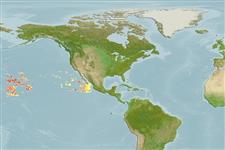Classification / Names
Common names | Synonyms | Catalog of Fishes(genus, species) | ITIS | CoL | WoRMS | Cloffa
Teleostei (teleosts) >
Perciformes/Cottoidei (Sculpins) >
Liparidae (Snailfishes)
Etymology: Paraliparis: Greek, para = the side of + Greek, liparis = fat (Ref. 45335); hawaiiensis: Named for its type locality, Hawaii..
Environment: milieu / climate zone / depth range / distribution range
Ecology
Marine; bathydemersal; depth range 2196 - 3055 m (Ref. 95901). Deep-water
Eastern Central Pacific: Hawaii.
Size / Weight / Age
Maturity: Lm ? range ? - ? cm
Max length : 15.1 cm TL male/unsexed; (Ref. 95901); 14.9 cm TL (female)
Short description
Morphology | Morphometrics
Vertebrae: 68 - 69. This species is distinguished by the following characters: total vertebrae 68-69; pectoral-fin rays 20-21, no rudimentary rays; 7 caudal-fin rays; radials 2+0+1; chin pores almost touching, in a deep transversely oval pigmented pit appearing to be a pore, with a pair of rudimentary pores symmetrically located immediately posterior to the pit; short head short, about 16% SL; upper jaw about half its head length (HL); teeth simple canines forming moderately wide bands; snout about a quarter HL (Ref. 95901).
The holotype apparently has ripe eggs up to 4.2 mm in diameter (Ref. 95901).
Life cycle and mating behavior
Maturity | Reproduction | Spawning | Eggs | Fecundity | Larvae
Stein, D.L. and J.C. Drazen, 2014. Paliparis hawaiiensis, a new species of snailfish (Scorpaeniformes: Liparidae) and the first described from the Hawaiian Archipelago. J. Fish Biol. 84(5)1519-1526. (Ref. 95901)
IUCN Red List Status (Ref. 130435)
Threat to humans
Harmless
Human uses
More information
Common namesSynonymsMetabolismPredatorsEcotoxicologyReproductionMaturitySpawningSpawning aggregationFecundityEggsEgg development
Age/SizeGrowthLength-weightLength-lengthLength-frequenciesMorphometricsMorphologyLarvaeLarval dynamicsRecruitmentAbundanceBRUVS
ReferencesAquacultureAquaculture profileStrainsGeneticsElectrophoresesHeritabilityDiseasesProcessingNutrientsMass conversion
Tools
Special reports
Download XML
Internet sources
Estimates based on models
Preferred temperature (Ref.
123201): 1.5 - 1.9, mean 1.7 °C (based on 14 cells).
Phylogenetic diversity index (Ref.
82804): PD
50 = 0.5000 [Uniqueness, from 0.5 = low to 2.0 = high].
Bayesian length-weight: a=0.00525 (0.00237 - 0.01161), b=3.15 (2.96 - 3.34), in cm total length, based on LWR estimates for this (Sub)family-body shape (Ref.
93245).
Trophic level (Ref.
69278): 3.5 ±0.5 se; based on size and trophs of closest relatives
Resilience (Ref.
120179): High, minimum population doubling time less than 15 months (Preliminary K or Fecundity.).
Fishing Vulnerability (Ref.
59153): Low vulnerability (10 of 100).
